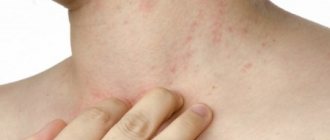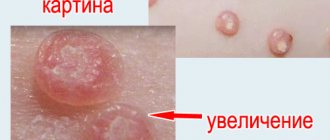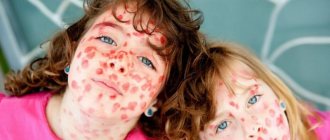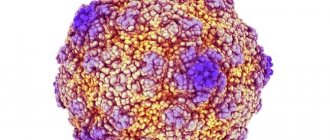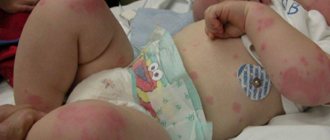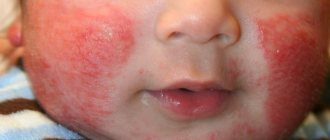This disease, medically called Henoch-Schönlein syndrome or allergic (rheumatic) purpura, is diagnosed mainly in patients aged 5-13 years. In adults, cases of hemorrhagic vasculitis are also common.
It occurs less frequently in children under 3 years of age. The development of this disease is always associated with damage to the walls of vascular beds, an increase in the degree of their permeability, activation of the protein metabolism process, and increased production of immune responses.
- Signs and symptoms of hemorrhagic vasculitis, photo
- Forms of hemorrhagic vasculitis
Hemorrhagic vasculitis: skin-articular form
- Complications of hemorrhagic vasculitis
What it is?
Henoch-Schönlein disease, rheumatic purpura or hemorrhagic vasculitis are the names of a benign disease that causes a lot of trouble. This disease is characterized by the presence of an inflammatory process in the walls of small vessels, which affects the skin, joints, intestinal tract and kidneys. In some cases, the disease affects the vascular network of the lungs, as well as the vessels and membranes of the brain.
All ages are susceptible to the disease, but the disease most often affects children of the senior preschool - primary school periods, approximately 4-12 years of age. Girls and women suffer much less often than the opposite sex. According to statistics, the peak incidence occurs in the spring months.
Forms
In pediatric practice, there are four main forms of pathology:
- Simple - in this case, red dots appear only on the epidermis;
- Rheumatoid - in this form, the patient, in combination with rashes, inflames some joints;
- Fulminant is a rather dangerous type of vasculitis, with it, in addition to the presence of rashes on the upper layers of the skin, the process also involves blood vessels, the heart and kidneys, and the central nervous system suffers;
- Abdominal is also a fairly severe form of pathology, in which the baby’s epidermis, stomach and intestines are damaged, and there is constant severe pain in the abdomen.
The course of the disease itself occurs in several stages:
- Initially, for about a week, the child suffers from the acute stage;
- A sign of the pathology transitioning to a protracted form is the persistence of symptoms for 60 days or more;
- With constant, periodic occurrence and attenuation of the manifestations of the disease, doctors diagnose a chronically relapsing stage.
It is the last stage of pathology that poses the greatest danger to the child. At this time, he may develop the following complications:
- violation of the integrity of the small or large intestine, so-called perforation;
- due to the possibility of penetration of one part of the intestine into another part, there is a risk of complete or partial obstruction, which is called intussusception;
- hemorrhages in the gastrointestinal tract cannot be ruled out;
- Inflammatory processes may develop in the abdominal cavity;
- Due to severe bleeding and loss of large amounts of blood, children often develop acute posthemorrhagic anemia.
Even without a medical education, you can understand how strong and life-threatening all complications are for a child, both individually and in combination. Considering this, all diagnosed cases of hemorrhagic vasculitis are subject to immediate medical intervention with subsequent observation.
Causes
Hemorrhagic vasculitis belongs to a group of diseases characterized by disruption of autoimmune processes in the body. The trigger for the onset of the disease is an allergic reaction.
The trigger can be any component, from food, an insect bite to vaccines, viruses or bacteria. Hemorrhagic vasculitis begins acutely, as does almost any manifestation of allergy.
As a result, inflammation develops, which increases capillary permeability. Due to the “fragility” of the vessels, small blood clots and bruises (hemorrhages) form inside them. Externally, this is manifested by the appearance of pinpoint hemorrhages under the skin.
Experts tend to believe that allergies are only a consequence, while the real cause is a genetic predisposition to inadequate reactions of the body to an allergen. If, in addition to this, there is still a focus of chronic infection, then the disease is more likely to manifest itself in full force.
Causes
The specific causes of the disease have not yet been identified .
The main version is a failure in the human immune system, after which one’s own antibodies “attack” the walls of blood vessels, but why this happens remains a mystery.
After an attack by antibodies, the vessels become weak and loose, which causes hemorrhages and microthrombi.
Factors that trigger the launch of the autoimmune process mechanism may be:
- use of antibiotics;
- allergies to food or medications;
- presence of chronic infectious diseases;
- previous injuries or surgeries;
- past infectious diseases (scarlet fever, influenza, tonsillitis, etc.);
- vaccinations and vaccinations;
- the presence of worms;
- congenital DNA pathologies.
Heredity plays a huge role , that is, the disease is most likely transmitted from parents to children.
How to treat an anal fissure in a child? Find out about this from our article.
Symptoms of the disease
The very first signs are urticaria, abdominal pain, a characteristic rash and a positive pinching symptom, when pinching a large number of small hemorrhages on the skin. There is also an increase in body temperature.
Depending on the direction in which the disease develops, several forms are distinguished. Each of them has its own characteristic manifestations:
- Simple or cutaneous form.
Rash with hemorrhagic vasculitis
This option is most common and is characterized by rashes on the skin. At first, the rash occurs in the form of small, widely spaced blisters and vesicles, which become larger as the disease progresses until they merge together.
Often the rashes are localized on the lower extremities and buttocks, sometimes appearing on the torso. In young patients, a rash is observed even on the soft palate and oral mucosa.
Rash in the mouth
A distinctive feature of such rashes is their symmetry. In particularly severe cases, areas of skin cell death and the formation of crusts are noted. After recovery, pigmentation remains at the site of the rash, which does not disappear for a long time.
- Articular shape.
This option rarely appears in its pure form; most often it is combined with symptoms of simple hemorrhagic vasculitis. Patients note severe pain in large joints, which either subsides or intensifies again, as well as swelling in them.
In children, articular syndrome, as a rule, quickly disappears without leaving behind bone deformities.
- Abdominal form.
A characteristic symptom of this form of the disease is the presence of severe cramping abdominal pain, accompanied by vomiting and nausea, and in severe cases, gastric bleeding. Painful sensations are replaced by a period of relative well-being, but after a couple of hours they intensify again.
The main danger is the fact that pain complicates diagnosis, because similar symptoms can be observed with appendicitis, intestinal obstruction, perforation of an ulcer and other emergency conditions.
In most pediatric patients, the abdominal form is perhaps the very first sign of the onset of the disease.
- Kidney form.
As the name suggests, the kidneys are primarily affected here. The main symptom is cloudy or sedimenty urine mixed with blood. This variant of the development of the disease is quite rare, but it is fraught with very serious complications.
- Malignant form . With this variant of the development of the disease, a lightning-fast course is observed, when all the symptoms appear very quickly.
If the blood vessels of the brain and its membranes are damaged, severe headaches, convulsions, numbness of the limbs, pseudoepileptic seizures, and a sharp rise in body temperature to high values may appear. Inflammatory processes in the organs of vision are accompanied by hemorrhage into the sclera.
All symptoms can be expressed to varying degrees at the same time.
Features of the course and diagnosis
Children have some features of the course of this disease. For example, in 50% of cases, young patients do not develop a skin rash, which makes diagnosis difficult. In addition, in children the prognosis of the disease is more favorable than in adults, and if treatment and the right diet are prescribed in a timely manner, the symptoms of hemorrhagic vasculitis disappear within several months.
The diagnosis is confirmed by the presence of a symmetrically located rash characteristic of vasculitis. Fortunately, it is the skin form of the pathology that occurs most often in children, so after examining a small patient, the doctor confirms the diagnosis using laboratory tests. However, the difficulty lies in diagnosing the renal, rheumatoid and abdominal forms if the first symptoms are not associated with the appearance of skin rashes. Therefore, in order to differentiate this disease from others with similar symptoms, the following is indicated:
- ECG;
- chest radiography;
- Ultrasound of the abdominal organs.
Features of the disease in children
Young patients have their own characteristics during the course of the disease. As a rule, hemorrhagic vasculitis in them begins acutely with the appearance of abdominal pain. In this case, Quincke's edema and the presence of exudate in the cavities may be noted.
It is also possible that a functional systolic murmur may appear in the heart, which is not typical for older patients. Boys sometimes experience testicular damage on both sides.
In most cases, the development of the disease in children is caused by hypothermia, vaccination, or a severe viral infection. A fulminant course, generalization of the inflammatory process and a tendency for the disease to return are very typical for young patients.
What are the differences between symptoms in adults and children?
Let us describe the external manifestations in an adult:
- Erased signs at the beginning, the overall clinical picture is more mild;
- The presence of abdominal syndrome accompanies half of the diseases with hemorrhagic vasculitis in adulthood;
- If the disease affects the kidneys, this leads to glomerulonephritis and kidney failure;
Photo 2. Symptoms on the hands of an adult
Pediatric hemorrhagic vasculitis is different:
- Symptoms of acute fever, observed in a third of all sick children;
- The early stage is acute;
- A disorder of the gastrointestinal tract is accompanied by loose stools with traces of blood;
- Kidney damage almost always occurs at an early stage;
Photo 3. Signs of vasculitis in children
Classification of the disease
Hemorrhagic vasculitis is classified depending on the course of the disease and the severity of manifestations.
There are acute (lasting up to two months), protracted (lasting at least six months) and chronic course of hemorrhagic vasculitis.
Based on the severity of manifestations, the following forms are distinguished:
– mild degree . The child has a slight rash, and his general condition is relatively satisfactory.
– moderate severity . The rashes are more widespread and numerous, and may be accompanied by pain in the abdomen and joints. In some cases, changes in the urine are observed.
– severe degree . The risk of developing various complications sharply increases: necrosis of rash elements, damage to the kidneys and gastrointestinal tract, fraught with bleeding.
Treatment
In the acute period, it is necessary to hospitalize the patient. Maintain bed rest. A strict thermally and mechanically gentle hypoallergenic diet is prescribed (especially for abdominal syndrome).
In case of Henoch-Schönlein disease, the basic therapy is complex antithrombotic therapy (heparin, antiaggregates and indirect fibrinolysis activators).
The dose of heparin is selected individually depending on the severity of the disease (on average 300-500 units/kg, rarely higher doses). The drug is administered subcutaneously 3-4 times a day, intravenously up to 6 times a day for 4-8 weeks, gradually being withdrawn under the control of blood clotting time. Desag-regents include chimes (3-5 mg/kg per day), trental; III generation antiplatelet agents include ibustrin, ticlopedine (ticlid).
You can prescribe NSAIDs (Voltaren, indomethacin), which relieve articular syndrome and reduce platelet aggregation. To activate fibrinolysis, nicotinic acid and its derivatives are used: xanthinol nicotinate, theonicol, complamin.
In severe cases of the disease in the acute period, GCS is used in a daily dose of 0.5-1.0 mg/kg (short course), intravenous administration of rheopolyglucin, glucosone-caine mixture (in a ratio of 3:1), and plasmapheresis sessions are performed. Antibiotics are prescribed only in the presence of focal infection.
Diagnostics
A number of factors are taken into account when making a diagnosis. In the first place is the symmetry of the rashes characteristic of hemorrhagic vasculitis. Attention is also drawn to the presence of articular and abdominal syndromes.
But in some cases, especially in children, the rash may be absent altogether, as well as joint pain. A correct diagnosis can be made through careful observation of the patient, medical history, clinical manifestations, laboratory and diagnostic tests.
Urine and blood tests, both general and specific (for the content of immunoglobulins, Zimnitsky test, etc.), fibrogastroduodenoscopy, ultrasound of the abdominal cavity and kidneys can confirm the diagnosis. If the picture of the disease is unclear, a biopsy of the rash elements is performed.
Abdominal ultrasound
The diagnosis and treatment of hemorrhagic vasculitis is carried out by a rheumatologist. If necessary, the patient consults a nephrologist and a surgeon.
Diagnosis of hemorrhagic vasculitis
The changes that the patient’s biological samples undergo during laboratory examination cannot be called specific. To confirm the diagnosis, pay attention to the level of:
- ESR;
- platelets;
- leukocytes;
- alpha-2-globulins;
- immunoglobulins A and G;
- reactive proteins;
- seromucoids;
- fibrinolysis;
- fibrinogen;
- cryoglobulins;
- DFA;
- antihyaluronidase;
- fibrin monomers;
- antistreptolysin.
During research, it is necessary to differentiate hemorrhagic vasculitis. Diagnosing the disease is not difficult for doctors.
The difficulty may lie only in determining its form of development and the possibility of confusing, for example, the abdominal form of pathology with some other disease:
- intestinal obstruction;
- pancreatitis;
- cholecystitis;
- peritonitis;
- inflammation of the appendix.
Also, hemorrhagic papules can be one of the manifestations of:
- thrombocytopenia;
- cryoglobulinemic vasculitis;
- paraneoplastic syndrome;
- sepsis;
- meningococcal meningitis.
Treatment and diet
Due to the fact that the trigger for the development of the disease in most cases is the entry of an allergen into the body, treatment is carried out only in a hospital in order to prevent the development of emergency conditions and complications.
The child is prescribed strict bed rest for up to three to four weeks. Drug treatment includes the use of drugs that prevent the formation of blood clots and improve blood circulation. Hormone therapy is prescribed for severe allergic reactions or long-lasting pain. To speed up the healing of skin damage, auxiliary products are used in the form of ointments for external use.
Antihistamines and non-steroidal anti-inflammatory drugs are also used, and antibiotic therapy is prescribed if indicated. In severe cases, plasmapheresis is indicated.
Another important condition is to follow a diet that excludes hyperallergenic foods (milk, eggs, chocolate, citrus fruits, etc.).
It is necessary to eat as much fresh fruits and vegetables rich in vitamin C as possible. A restriction in the diet of spicy, fried and fatty foods is indicated. It is recommended to take food five to six times during the day, and it should be at a comfortable temperature. If there are pronounced renal or abdominal syndromes, then a therapeutic diet is prescribed with the exception of salt and meat dishes.
The duration of treatment for hemorrhagic vasculitis depends on the severity of the disease, but even with a mild course it lasts at least two months.
Hemorrhagic vasculitis: what is it?
Hemorrhagic vasculitis is a systemic disease of a series of vasculitis, characterized by damage to the walls of the smallest vessels of the body - capillaries, venules and arterioles. This condition is always accompanied by a violation of the structure of these blood vessels.
As a rule, the disease occurs with the presence of aseptic inflammation, which significantly increases the likelihood of blood clots. In the presence of rheumatic purpura, not only the blood vessels of the skin are affected, but also the internal organs (joints, kidneys, gastrointestinal tract).
Causes of hemorrhagic vasculitis
The main trigger of this disease is infection of various etiologies. These could be fungi, bacteria or viruses. The development of the disease is also influenced by the use of certain medications and the unfavorable environmental conditions in which the patient lives.
Predisposing factors to the occurrence of hemorrhagic vasculitis are:
- insect bites;
- thermal burns;
- injuries of various origins;
- intoxication due to biological poisons entering the body;
- vaccination procedures;
- congenital functional disorders of the immune system;
- colds;
- overheating or hypothermia of the body;
- allergic reactions caused by food agents.
The danger of sunburn for the human body, their treatment and prevention of complications:
Prognosis, observation and prevention
Most often, with timely treatment and an integrated approach, the prognosis of the disease is favorable. With the development of a fulminant form with brain damage or severe kidney damage, death is possible.
Within a year after suffering the disease, almost all patients recover; only in some cases the disease becomes chronic, when improvement alternates with the return of symptoms.
After hemorrhagic vasculitis, children are registered at the dispensary for five years, and in case of kidney damage - until adulthood. It is necessary to regularly take blood and urine tests, as well as promptly sanitize foci of chronic infection.
After recovery, immunoprophylaxis with any types of vaccines is excluded for two to three years. It is recommended to follow a hypoallergenic diet throughout the year.
In the future, to prevent relapses, vaccination against tuberculosis is not carried out, and antibiotic therapy, when indicated, is carried out strictly under the supervision of a doctor. Parents also need to ensure that a child who has suffered hemorrhagic vasculitis does not become hypothermic and does only feasible physical activity. If the doctor’s recommendations are followed, the disease usually recedes forever.
Treatment methods
This disease is treated by a rheumatologist .
If complications arise, a surgeon, nephrologist and other specialists may be involved.
In the acute form, the patient must be hospitalized.
He needs to be provided with bed rest and complete rest to reduce movement of the limbs and reduce the likelihood of hemorrhages. The patient is prescribed various groups of drugs:
- Enterosorbents - to remove toxins from the intestines (activated carbon or Enterosgel).
- Anticoagulants - to dissolve blood clots and prevent blockage of blood vessels (Fraxiparin, Heparin).
- Antiplatelet agents - improve blood circulation and prevent the formation of blood clots (Ticlopidine, Aspirin, Curantil, Trental).
- Antihistamines - to prevent an allergic reaction (Claritin, Tavegil, Ketotifen).
- Glucocorticoids – suppress the immune system and have an anti-inflammatory effect (Methylprednisolone, Prednisolone).
- Antibiotics – destroy infections if the disease is accompanied by other infectious diseases.
Non-steroidal anti-inflammatory drugs are used as additional therapy to relieve inflammation, reduce pain and as an antipyretic (Indomethacin, Diclofenac, Ibuprofen).
Also effective in suppressing the immune system are cytostatics , which reduce the allergic reaction and the production of antibodies.
On the other hand, various vitamin complexes and calcium supplements are useful to strengthen the body.
Antispasmodics (No-Shpa, Drotaverine, Papaverine) are used to relieve pain Treatment should only be carried out under the supervision of a physician.
The effect of traditional medicine can be unpredictable, since the disease is autoimmune in nature. The choice of drugs, dosage and course of treatment can only be prescribed by a doctor and only after conducting all the necessary studies.
What can cause the disease
Parents of children who have been diagnosed with this pathology are looking for the causes of the disease. Why do children get sick and why does this happen? A dermatologist helped us find the answer to this question. First of all, the disease is caused by infections.
It can be a consequence of influenza, acute respiratory viral infection (ARVI), scarlet fever, tonsillitis or chickenpox. During such infectious pathologies, the walls of the capillaries are damaged, and as a result, the production of agents in the immune system increases.
There are also a number of other reasons that relate to the provocateurs of the manifestation of hemorrhagic vasculitis, these are:
- getting injured;
- unsuccessful vaccination;
- allergic reaction to medications;
- any degree of hypothermia;
- each of the allergic reactions.
To avoid this disease, each treatment must be carried out only with the permission of a specialist.
How to treat
The treatment process must take place strictly in a hospital under the supervision of doctors. After the course of treatment, children are examined in a children's clinic and discharged home. After discharge, a visiting nurse comes to monitor the patient’s condition for 1–2 weeks. In the hospital, drug treatment lasts 3 to 6 weeks, depending on the degree of advanced disease.
For the first three weeks, patients are prescribed strict bed rest, which must be adhered to. Then, little by little, doctors allow you to get up, the duration of the walk starts from 5 minutes a day. And every day you can increase the time by 3–5 minutes.
There is a list of products that a patient is prohibited from bringing to the hospital:
- chocolate;
- fresh berries;
- cocoa-containing products and cocoa itself;
- citrus;
- coffee.
The main medicinal substance is heparin. The dosage for children is calculated by the attending physician. Basically, 250 - 400 units fall per 1 kg of weight. The amount of the drug in the body is monitored using a test called autocoagulation. The course of treatment includes sorbents to remove toxins from the body, and vascular agents, since pathology can cause complications on the heart muscle.
Doctors categorically prohibit treatment with folk remedies for this pathology. Everything must happen strictly under the supervision of specialists.
